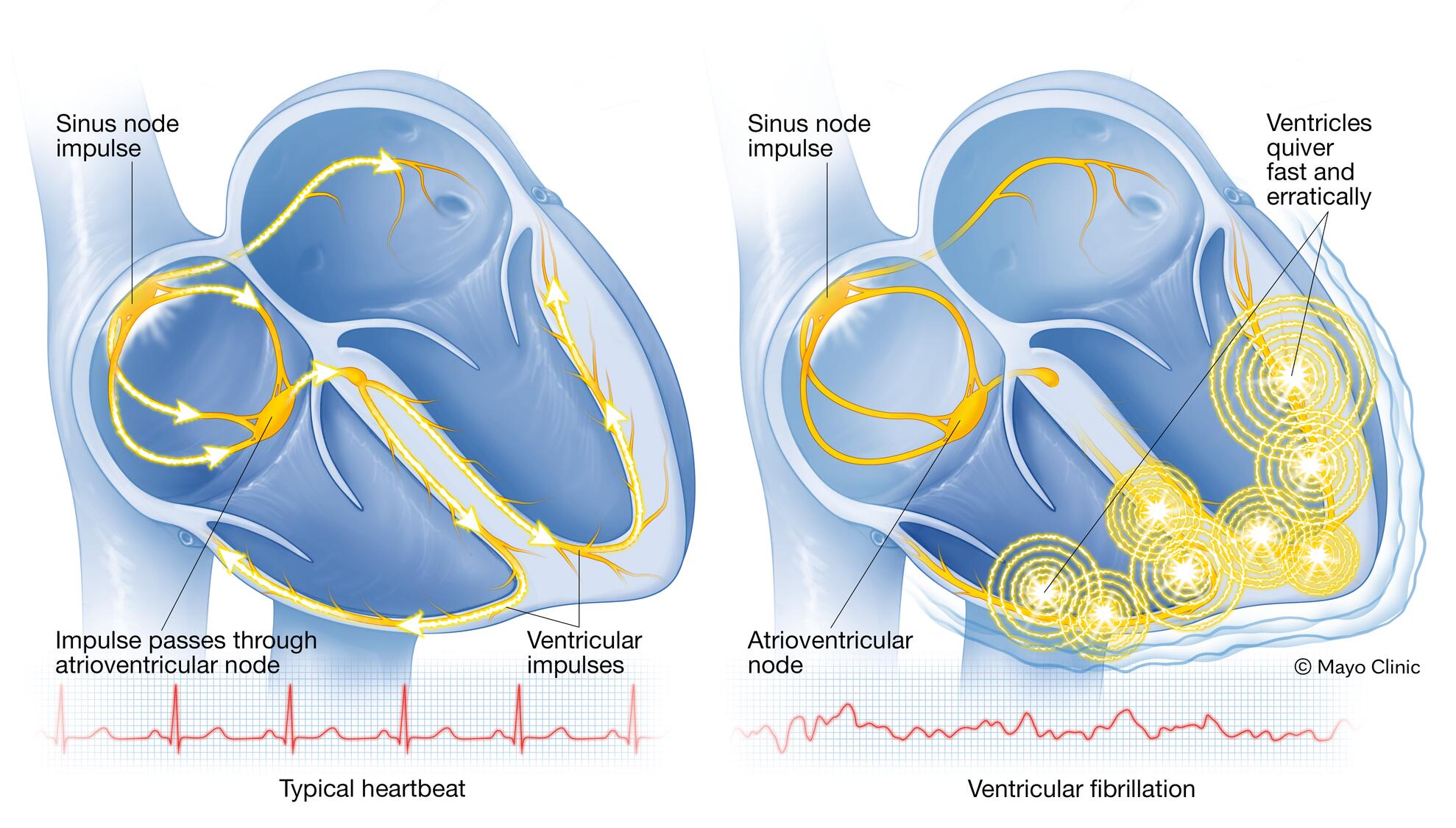Overview
Ventricular fibrillation is a type of irregular heart rhythm (arrhythmia). During ventricular fibrillation, the lower heart chambers contract in a very rapid and uncoordinated manner. As a result, the heart doesn't pump blood to the rest of the body.
Ventricular fibrillation is an emergency that requires immediate medical attention. It's the most frequent cause of sudden cardiac death.
Emergency treatment for ventricular fibrillation includes cardiopulmonary resuscitation (CPR) and shocks to the heart with a device called an automated external defibrillator (AED). Medications, implanted devices or surgery may be recommended to prevent episodes of ventricular fibrillation.
Ventricular fibrillation may also be called VFib, V-fib or VF.
Symptoms
Collapse and loss of consciousness are the most common symptoms of ventricular fibrillation.
Before a ventricular fibrillation episode, you may have symptoms of an irregularly fast or erratic heartbeat (arrhythmia). You may have:
- Chest pain
- Very fast heartbeat (tachycardia)
- Dizziness
- Nausea
- Shortness of breath
When to see a doctor
Make an appointment with a heart doctor (cardiologist) if you have an unexplained fast or pounding heartbeat.
If you see someone collapse, seek emergency medical help immediately. Follow these steps:
- Call 911 or your local emergency number.
- If the person is unconscious, check for a pulse.
- If no pulse, begin cardiopulmonary resuscitation (CPR) to help keep blood flowing through the body until an automated external defibrillator (AED) is available. The American Heart Association recommends hands-only CPR. Push hard and fast on the person's chest — about 100 to 120 times a minute. It's not necessary to check the person's airway or deliver rescue breaths. Continue until emergency medical help arrives.
- Use an automated external defibrillator (AED) as soon as it's available. Deliver a shock following the prompts on the device.
Causes
Ventricular fibrillation is caused by either:
- A problem in the heart's electrical properties
- A disruption of the blood supply to the heart muscle

Ventricular fibrillation
In a typical heart rhythm, electrical signals travel from the heart's upper chambers (atria) to the heart's lower chambers (ventricles), causing the ventricles to contract and pump blood. In ventricular fibrillation, rapid, irregular electrical signals cause the ventricles to quiver uselessly instead of pumping blood.
Sometimes, the cause of ventricular fibrillation is unknown.
To understand more about how ventricular fibrillation occurs, it may be helpful to know how the heart typically beats.
The heartbeat
The typical heart has four chambers — two upper chambers (atria) and two lower chambers (ventricles). Within the upper right chamber of the heart (right atrium) is a group of cells called the sinus node. The sinus node is the heart's natural pacemaker. It produces the signals that start each heartbeat.
These electrical signals move across the atria, causing the heart muscles to squeeze (contract) and pump blood into the ventricles.
Next, the signals arrive at a cluster of cells called the atrioventricular (AV) node, where they slow down. This slight delay allows the ventricles to fill with blood. When the signals reach the ventricles, the lower heart chambers contract and pump blood to the lungs or to the rest of the body.
In a typical heart, this heart signaling process usually goes smoothly, resulting in a typical resting heart rate of 60 to 100 beats a minute. But in ventricular fibrillation, rapid, irregular electrical signals cause the lower heart chambers to quiver uselessly instead of pumping blood.
Risk factors
Things that may increase the risk of ventricular fibrillation include:
- A previous episode of ventricular fibrillation
- A previous heart attack
- A heart problem present at birth (congenital heart defect)
- Heart muscle disease (cardiomyopathy)
- Injuries that cause damage to the heart muscle, such as being struck by lightning
- Drug misuse, especially with cocaine or methamphetamine
- A severe imbalance of potassium or magnesium
Complications
Without immediate treatment, ventricular fibrillation can cause death within minutes. The condition's rapid, erratic heartbeats cause the heart to abruptly stop pumping blood to the body. Blood pressure drops suddenly and significantly. The longer the body lacks blood, the greater the risk of damage to the brain and other organs.
Ventricular fibrillation is the most frequent cause of sudden cardiac death. The risk of other long-term complications depends on how fast treatment is received.